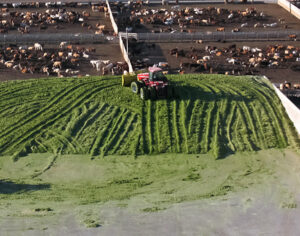Barley Variety and Silage Quality
This article written by Dr. Reynold Bergen, BCRC Science Director, originally appeared in the December 2016 issue of Canadian Cattlemen magazine and is reprinted on the BCRC Blog with permission of the publisher.

Barley silage is the main roughage fed in Western Canadian feedlots, but few barley breeders try to improve its feed quality. Most breeders focus on improved grain yields, malting characteristics and better disease and lodging resistance, and pay little attention to feed quality traits like protein, starch, or neutral detergent fiber (NDF) content and digestibility (NDFD).
NDF is a measure of “structural carbohydrates”, the parts of the plant that hold it up. Cattle digest NDF slowly, so NDF contributes to gut fill and can limit feed intake, growth and efficiency. In a Beef Cluster funded study published earlier this year, Dr. John McKinnon and colleagues compared 80 silage samples collected from farms from across Saskatchewan and Alberta, that had been produced from seven different barley varieties (Nair et al., Can. J. Anim. Sci. 96:598-608). In an upcoming paper, they compared three of the two-row varieties that had produced silage with similar protein, starch and NDF levels, but different NDFD, and their effects on feedlot performance and carcass traits.
What they did
Varieties previously shown to produce silage with high NDFD (CDC Cowboy, a general purpose variety with high forage yield), intermediate NDFD (CDC Copeland, a malting variety), and low NDFD (Xena, a general purpose feed variety) were grown at the University of Saskatchewan, managed the same, and silaged without an inoculant at mid-dough. The three silages were fed to 288 steers averaging 705lbs in a small pen feeding trial (12 head per pen). Diets were identical except for the type of silage used. Steers were backgrounded for 68 days. At 850lbs, the steers stepped up to a finishing diet over 12 days, then finished for 148 days and shipped at 1378lbs. Intakes, gains and conversions were measured throughout the feeding trial, and carcass weights and grades were collected at slaughter.
What they learned
Lab analyses indicated that these barleys didn’t ensile the same way as previously. This time, CDC Cowboy silage had more NDF and less starch and thus less energy than the CDC Copeland or Xena silages. These differences were also evident in the analysis of backgrounding diets formulated with these silages.
Backgrounding steers fed CDC Cowboy silage grew more slowly, ate less and converted less efficiently than steers fed CDC Copeland or Xena silage. The higher NDF levels in the CDC Cowboy silage likely limited feed intake, dietary energy intake and growth.
Finishing steer performance was unaffected by barley variety, probably because there was so much less silage in the diet.
Over the entire feeding period, the variety of barley used to make the silage had no measurable effects on steer performance. The differences in growth performance seen in the 68 day backgrounding period were diluted by the lack of differences in the longer 148 day finishing period.
Carcass lean yield and quality (marbling) grade were unaffected by the variety of barley used to make the silage, but steers fed CDC Cowboy silage had lighter carcasses (797lbs) than those fed CDC Copeland (817lbs) or Xena silage (811lbs).
What it means
The varieties did not reproduce the silage quality observed in the earlier study. Previously, all three varieties had produced silage with similar protein, starch and NDF; the only thing that differed was NDFD. This would have suggested that silage made from CDC Cowboy (most digestible NDF) would produce better animal performance than CDC Copeland (intermediate NDFD) and Xena (lowest NDFD). In this study, silage made from CDC Cowboy actually had higher NDF than the silage made from CDC Copeland and Xena. As a result, steers fed silage made from CDC Cowboy had poorer performance (lower feed intake, energy intake, growth rate and feed efficiency) during the high silage backgrounding period. This is probably a result of “genotype by environment interaction”. Different varieties of plants (or animals) perform differently in different growing conditions. Some thrive under optimal conditions and wilt under adverse conditions. Year-to-year variations in rainfall and temperature conditions, and soil type and fertility can influence how different barley varieties grow and mature, and the quality of the silage they produce.
While this study suggests that barley variety alone may not be a great predictor of animal performance, it certainly emphasizes the importance of feed testing. In winter feeding programs, forages with high NDF levels can prevent cows from consuming enough feed to maintain their body condition.
These results don’t mean that breeding barley for improved nutritional value is pointless. Remember that these barleys were not actually bred for low NDF or higher NDFD. Most of the feed and forage varieties on the market weren’t actually developed to be feed or forage varieties. They were usually intended for the malt or human food market, but didn’t make the grade. Alberta Agriculture’s Lacombe Field Crop Development Center’s barley breeding program is one of the few trying to improve barley forage quality, thanks to beef industry check-off funding. Over time, these efforts may lead to varieties that produce superior feed quality in a variety of growing conditions.
Click here to subscribe to the BCRC Blog and receive email notifications when new content is posted.
The sharing or reprinting of BCRC Blog articles is typically welcome and encouraged, however this article requires permission of the original publisher.
We welcome your questions, comments and suggestions. Contact us directly or generate public discussion by posting your thoughts below.